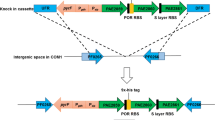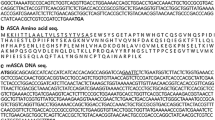Abstract
A novel metalloprotein containing a unique [S2MoS2CuS2MoS2]3− cluster, designated as Orange Protein (ORP), was isolated for the first time from Desulfovibrio gigas, a sulphate reducer. The orp operon is conserved in almost all sequenced Desulfovibrio genomes and in other anaerobic bacteria, however, so far D. gigas ORP had been the only ORP characterized in the literature. In this work, the purification of another ORP isolated form Desulfovibrio alaskensis G20 is reported. The native protein is monomeric (12443.8 ± 0.1 Da by ESI–MS) and contains also a MoCu cluster with characteristic absorption bands at 337 and 480 nm, assigned to S–Mo charge transfer bands. Desulfovibrio alaskensis G20 recombinant protein was obtained in the apo-form from E. coli. Cluster reconstitution studies and UV–visible titrations with tetrathiomolybdate of the apo-ORP incubated with Cu ions indicate that the cluster is incorporated in a protein metal-assisted synthetic mode and the protein favors the 2Mo:1Cu stoichiometry. In Desulfovibrio alaskensis G20, the orp genes are encoded by a polycistronic unit composed of six genes whereas in Desulfovibrio vulgaris Hildenborough the same genes are organized into two divergent operons, although the composition in genes is similar. The gene expression of ORP (Dde_3198) increased 6.6 ± 0.5 times when molybdate was added to the growth medium but was not affected by Cu(II) addition, suggesting an involvement in molybdenum metabolism directly or indirectly in these anaerobic bacteria.





Similar content being viewed by others
References
George GN, Pickering IJ, Yu EY, Prince RC, Bursakov SA, Gavel OY, Moura I, Moura JJG (2000) J Am Chem Soc 122:8321–8322
Bursakov SA, Gavel OY, Di Rocco G, Lampreia J, Calvete J, Pereira AS, Moura JJG, Moura I (2004) J Inorg Biochem 98:833–840
Carepo MSP, Pauleta SR, Wedd AG, Moura JJG, Moura I (2014) J Biol Inorg Chem 19:605–614
Ala A, Walker AP, Ashkan K, Dooley JS, Schilsky ML (2007) Lancet 369:397–408
Alvarez HM, Xue Y, Robinson CD, Canalizo-Hernandez MA, Marvin RG, Kelly RA, Mondragon A, Penner-Hahn JE, O’Halloran TV (2010) Science 327:331–334
Bissig KD, Voegelin TC, Solioz M (2001) FEBS Lett 507:367–370
Blackburn NJ (2010) Chem Biol 17:8–9
Brewer GJ (2000) J Trace Elem Exp Med 13:51–61
Brewer GJ (2005) Curr Cancer Drug Tar 5:195–202
George GN, Pickering IJ, Harris HH, Gailer J, Klein D, Lichtmannegger J, Summer KH (2003) J Am Chem Soc 125:1704–1705
Laurie SH (2000) Eur J Inorgan Chem 2000:2443–2450
Wu DX, Hong MC, Cao R, Liu HQ (1996) Inorg Chem 35:1080–1082
Jeannin Y, Secheresse F, Bernes S, Robert F (1992) Inorg Chim Acta 198:493–505
McDonald JW, Friesen GD, Rosenhein LD, Newton WE (1983) Inorg Chim Acta 72:205–210
Muller A, Bogge H, Schimanski U, Penk M, Nieradzik K, Dartmann M, Krickemeyer E, Schimanski J, Romer C, Romer M, Dornfeld H, Wienboker U, Hellmann W, Zimmermann M (1989) Monatshefte Fur Chemie 120:367–391
Muller A, Diemann E, Jostes R, Bogge H (1981) Angewandte Chemie-Int Ed English 20:934–955
Muller A, Sarkar S (1977) Angewandte Chemie-Int Ed English 16:705–707
Fievet A, My L, Cascales E, Ansaldi M, Pauleta SR, Moura I, Dermoun Z, Bernard CS, Dolla A, Aubert C (2011) J Bacteriol 193:3207–3219
Scholten JC, Culley DE, Brockman FJ, Wu G, Zhang W (2007) Biochem Biophy Res Commun 352:48–54
He Q, Huang KH, He Z, Alm EJ, Fields MW, Hazen TC, Arkin AP, Wall JD, Zhou J (2006) Appl Environ Microbiol 72:4370–4381
He Z, Zhou A, Baidoo E, He Q, Joachimiak MP, Benke P, Phan R, Mukhopadhyay A, Hemme CL, Huang K, Alm EJ, Fields MW, Wall J, Stahl D, Hazen TC, Keasling JD, Arkin AP, Zhou J (2010) Appl Environ Microbiol 76:1574–1586
Clark ME, He Q, He Z, Huang KH, Alm EJ, Wan XF, Hazen TC, Arkin AP, Wall JD, Zhou JZ, Fields MW (2006) Appl Environ Microbiol 72:5578–5588
Zhang W, Culley DE, Scholten JC, Hogan M, Vitiritti L, Brockman FJ (2006) Antonie Van Leeuwenhoek 89:221–237
Zhang W, Culley DE, Nie L, Scholten JC (2007) Appl Microbiol Biotechnol 76:447–457
Hauser LJ, Land ML, Brown SD, Larimer F, Keller KL, Rapp-Giles BJ, Price MN, Lin M, Bruce DC, Detter JC, Tapia R, Han CS, Goodwin LA, Cheng JF, Pitluck S, Copeland A, Lucas S, Nolan M, Lapidus AL, Palumbo AV, Wall JD (2011) J Bacteriol 193:4268–4269
Postgate JR (1984) The sulphate reducing bacteria. Cambridge University Press, Cambridge
Julie D, Thompson D, Higgins G, Gibson TJ (1994) Nucl Acids Res 22:4673–4680
Rivas MG, Carepo MS, Mota CS, Korbas M, Durand MC, Lopes AT, Brondino CD, Pereira AS, George GN, Dolla A, Moura JJ, Moura I (2009) Biochemistry 48:873–882
Cort, JR (2000) J Struct Funct Genomics 1:15–25
Etezady-Esfarjani T, Herrmann T, Peti W, Klock HE, Lesley SA, Wuthrich K (2004) J Biomol NMR 29:403–406
Cort JR, Yee A, Edwards AM, Arrowsmith CH, Kennedy MA (2000) J Struct Funct Genomics 1:15–25
Pauleta SR, Duarte AG, Carepo MS, Pereira AS, Tavares P, Moura I, Moura JJ (2007) Biomol NMR Assignm 1:81–83
Neca AJ, Soares R, Carepo MS, Pauleta SR (2015) Biomol NMR Assignm. doi:10.1007/s12104-015-9648-5
Hu Y, Ribbe MW (2013) J Biol Chem 288:13173–13177
Hu Y, Ribbe MW (2013) Biochim Biophys Acta 1827:1112–1122
Peters JW, Broderick JB (2012) Annu Rev Biochem 81:429–450
Najmudin S, Bonifacio C, Duarte AG, Pauleta SR, Moura I, Moura JJ, Romao MJ (2009) Acta crystallographica Section F. Struct Biol Crystall Commun 65:730–732
Quagraine EK, Reid RS (2001) J Inorg Biochem 85:53–60
Chidambaram MV, Barnes G, Frieden E (1984) J Inorg Biochem 22:231–239
Juarez JC, Betancourt O Jr, Pirie-Shepherd SR, Guan X, Price ML, Shaw DE, Mazar AP, Donate F (2006) Clin Cancer Res 12:4974–4982
Park KH, Park YD, Lee JR, Hahn HS, Lee SJ, Bae CD, Yang JM, Kim DE, Hahn MJ (2005) Biochim Biophys Acta 1726:115–120
Lee VE, Schulman JM, Stiefel EI, Lee CC (2007) J Inorg Biochem 101:1707–1718
Acknowledgments
We thank Fundação para a Ciência e Tecnologia (FCT) and the French National Research Agency for the financial supports (projects PTDC/QUI-BIQ/098071/2008 to IM, FCT-ANR/BBB-MET/0023/2012 to SRP and ANR-12-ISV8-0003-01 to CA) and scholarship SFRH/BD/87898/2012 (CC). This work was financed by National funds by FCT under the project PEst-C/EQB/LA0006/2013. SRP is an Investigador FCT fellow. MSPC was a Ciencia2007 FCT fellow and presently is a BJT-CAPES Researcher.
Author information
Authors and Affiliations
Corresponding authors
Rights and permissions
About this article
Cite this article
Carepo, M.S.P., Carreira, C., Grazina, R. et al. Orange protein from Desulfovibrio alaskensis G20: insights into the Mo–Cu cluster protein-assisted synthesis. J Biol Inorg Chem 21, 53–62 (2016). https://doi.org/10.1007/s00775-015-1323-x
Received:
Accepted:
Published:
Issue Date:
DOI: https://doi.org/10.1007/s00775-015-1323-x




